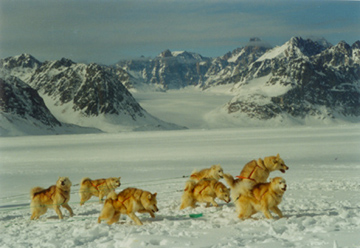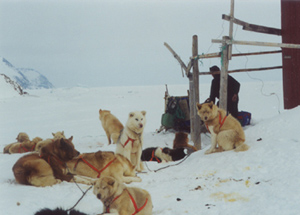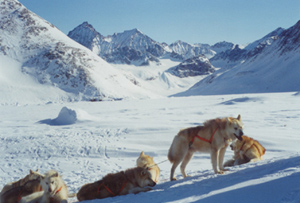Table of Contents
*
Featured Inuit Dog Owner: Merv Ehrich
*
Jubilee Medal Awarded to ISDI Co-Founder
*
Blue Eyes in Norwegian Greenland Dogs
*
ISD Enthusiasts Speak out on Blues Eyes
*
ISDI's Official Stand on Blue Eyes
*
Mountie, Alouette and Moose
*
Following Nanuk's Tracks
*
The Qitdlarssuaq Chronicles, Part 1
*
News Briefs:
New ISDI Scandinavia Web Site
Atanarjuat Update
Dog Teams in Iqaluit
Grammar Lesson
ISDs in Museum Exhibit
*
Poem: Lost Travellers
*
Book Review: first Nations.... first Dogs
*
ISD Enthusiast's First Novel Published
*
IMHO: Seeking to Answer the Wrong Question
Navigating This
Site
Index of articles by subject
Index
of back issues by volume number
Search The
Fan Hitch
Articles
to download and print
Ordering
Ken MacRury's Thesis
Our
comprehensive list of resources
Talk
to The
Fan Hitch
The Fan
Hitch home page
ISDI
home page
Editor: Sue Hamilton
Webmaster: Mark Hamilton
Contents of The Fan Hitch Website and its publications are protected by international copyright laws. No photo, drawing or text may be reproduced in any form without written consent. Webmasters please note: written consent is necessary before linking this site to yours! Please forward requests to Sue Hamilton, 55 Town Line Rd., Harwinton, Connecticut 06791, USA or mail@thefanhitch.org

Climbing the glacier Ockovsky photo
Following Nanuk's Tracks
by Lucian Ockovsky of Poprad, Slovak Republic
March 8, 2002. It's -28°C, with a strong west wind. We are near Sulussuulikajik, at 69°54'657", in East Greenland. My home in Poprad, Slovak Republic, is 3,323 km away.
I'm sitting on polar hunter Hjelmmer's sled pulled by twelve sturdy dogs with spiky ears and tails rolled up over their backs - twelve Greenland Inuit Sled Dogs.
This year, I'm not the upernadlet (the one who comes in the spring). Previously, I had come in April, sometimes at the end of March to travel through mountains and glaciers in the area of Tasiilak, nine hundred kilometers to the south. My memories are of images of the sun low above the horizon, sharp and quick shadows cast by the sharp peaks on the bright blue snow, rocky mountains rising from the white glacial falls flowing from the mountain glaciers, the white cap - Greenlandish Glacier behind and the bright blue sky above all of this. The white cap is called Semersuag by the Greenlanders and runs 3,200 km from north to south, 1,100 km from east to west and is 3,200 km high.
In my mind, I hear the rhythmic sound of forty-eight dog paws striking the harsh snow. My memory recalls the wagging of tails, the characteristic smell of dogs, and mixing with it the stench of the dead seal which became my seat as there is never enough space on the sled. I have experienced the sinister piterag - the blizzard blowing from the Semersuag to the sea which prevents hunters from harnessing the dogs, jumping into the sled and rushing toward the white horizons just to discover new horizons beyond.
I have also experience the nakajag - the rainy wind which blows in from the sea toward the glacier and prevents the men from following their desires about which real men never talk.
I remember the excitement after catching a seal in a net under the ice; the feeling of the primeval hunter watching the 30m long sperm whale, his white lower jaw emerging from the dark depths of the sea, less than three meters from our boat.
I experienced excitement, confusion, while dashing around and jumping into kayaks when the hunters noticed the narwal sporting the horn of the fabulous unicorn between floating icebergs. They were fascinated by the image of the harpoon stuck into its shining, spotted skin.
I remember the nostalgic and melancholic sunsets, the purple shadows cast on the opposite rocky slopes, the quiet of the polar night, the mysterious white, blue and green flames of the northern lights on the dark starry sky, and the choir of howling dogs, heads bent backward to send the greeting of their wolf ancestors to the fire in the sky.
I remember all this now, when I have been sitting for six hours on the sled and the temperature still is -28°C. I have gone through all this and through many other strong and unrepeatable experiences that have stimulated my imagination and fantasy up to now. But I had not experienced the Greenland winter and its most characteristic phenomena of polar conditions, low temperatures, storms and the meeting with pulabiar nanogo - as Greenlanders call the polar bear. All these images have galvanized my mind and imagination since the moment I boarded the plane in Nerlerit Inaat, last year.
Nanuk had a 4,000 years tradition in the Greenland mythology. He was the flying being, and because of his power and endurance, was the intermediary between the world of Inuit (people) and the powerful spirit Tronarsuag (the big spirit). Only the most powerful angagpg (shaman) could fly with him, freed from his human form in the third existence into the world of spirits.
The cold and the fierce ground blizzard bring me back to reality. Today is the ninth day of our journey. We have left behind the sites and the hunting cabins with such exotic names as Ittoggortoormiit, Makajik, Kangikajik, and Idersuaq. We are heading for Sulussuulikajik. Today is critical. The last time the dogs were fed was two days ago as the hunters didn't succeed in catching a seal for them. Both hunters often stop the sled and go to the sea ice with the gun and the nets. They search for seal breathing holes, but it's useless. I can feel they are not in the same mood as they were the previous days. Moreover, this day has been marred by an unpleasant incident. The heavy sled crushed one dog, broke his legs, and the hunter had to shoot him. Now we are left with eleven dogs, two of them under a year of age and only learning their place in the team. Besides all that, my left eye is frostbitten. I cannot squint and must press it painfully when taking pictures. I must hold the camera battery in my glove. After every shot I tell myself that it was the last one, but every new scene makes me forget this resolution. Finally, we come to the settlement of Sulu. The hunters quickly unload the sled, eat some cakes, and set off hunting in the bay, five kilometers away. It's nightfall but they are standing patiently near the seal holes in the hope that the seals will come out. A strong wind is blowing, so I turn the sled to make a windbreak and crouch in the lee. It's dark when we come back - empty handed.

Resting by the hunting
cabin
Ockovsky
photo
The house is deserted. The hunter died tragically last year and his wife and children moved away to relatives. All their belongings, clothes, books, papers, china are jumbled up. There are no photos. On the table, there is a half-burnt candle and an exercise book. I turn the pages of the exercise book. On the first page there is a poem:
Take me to the country of shadows
Where I can dream.
Take me to the country of laughter
Where I can laugh.
Take me to the open sea
Where I can swim...
For the inhabitants of this forlorn house, the dream will never come true. For us, however, the house is pleasantly warm and dry, not like the previous nights in the hunting cabins when we didn't make a fire, only separated from the -30°C outside by a thin wall of plywood. The hunters put their guns in front of the house as they do every night. In the night, we were awoken by the howling dogs. The hunters jumped out of their sleeping bags and ran out. They came back in very nervous.
We set off early in the morning. It was -20°C and sunny. The dogs are hungry, and we are nervous. In the afternoon, we arrive at Idersuarg, in a snow storm. We make tea, eat our biscuits and continue our journey on the sea ice, near the coast. The hunters hurry to the nets they dropped under the ice at Kangikajik. We go up the mountain slope to the ridge and the plateau. I turn my back to the blowing blizzard, but the hunters can't. I think that is why they all have chronic frostbite of the cornea. After a quick ride through the rocky and icy canyon, using rope brakes on the sled, we get down to the coastal ice. By evening we arrive at the Kangikajik hunting cabin. The hunters undo the sled, chain the dogs to their spots and despite the dark and the blizzard, set out to get the nets.
Here, they have always been successful hunting with nets, more so than hunting with guns, in bad and windy weather. Sweating, I catch up with the hunters. Hooray! There are three seals in the nets. I take pictures with the flash. We have food for the dogs. The situation is resolved, and we also have a good dinner of boiled seal.
Today, we took one team to come here from Sulu. We had used two teams to get there. Tired but satisfied, we get into our sleeping bags. In the morning, the radio announces heavy snow. This changes our plans. It's cloudy and -10°C. We cannot stay here any longer as we had planned otherwise. We could get stuck for a couple of days and I could miss my plane to Iceland.
After the quick six hours ride on the smooth sea ice and good snow, we reach Scoresby Sound, a settlement 46km away.
We didn't see the bear, only his week-old tracks between the rocks by the coast, when he was looking for his mate. Now, my thoughts are driven by another wish - to fly as the "flying nanuk” over the rocky mountains, icebergs, bays and sea back to that distant country, 3,323km away.

Ten minutes rest on the way up the mountain Ockovsky photo